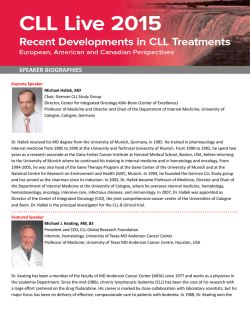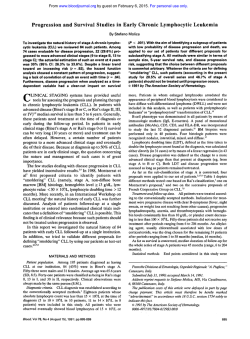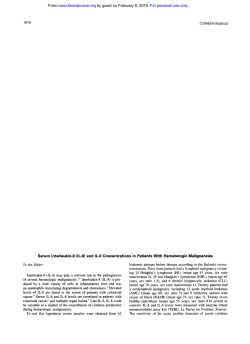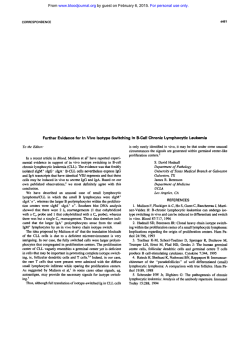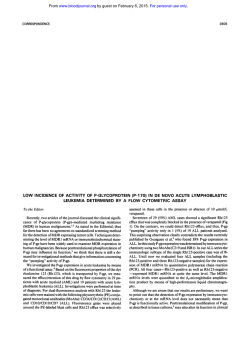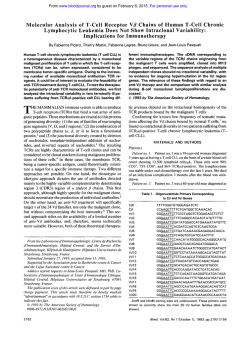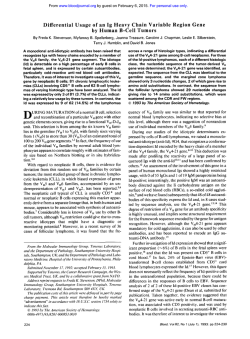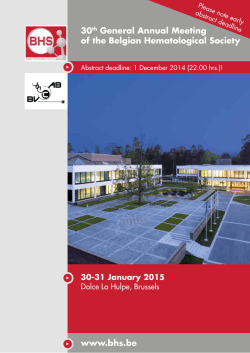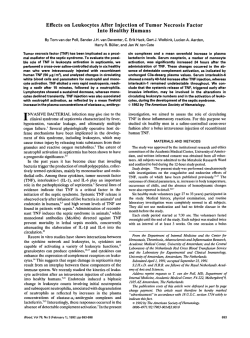
Appendix S1 - Cancer Letters
Supplementary Appendix Supplementary materials and methods Culture conditions Freshly isolated primary CLL cells were cultured in RPMI 1640 medium (Gibco, Grand Island, NY, USA), and MEC-1 cell line was cultured in Iscove's modified Dulbecco's medium (IMDM; Gibco), both of which were supplemented with 10% fetal bovine serum (FBS; HyClone, Logan, UT, USA), 2 mM L-glutamine, 100 U/mL penicillin, and 100 g/mL streptomycin at 37 °C in a humidified 5% CO2 incubator. Bone marrow stromal cells (BMSCs) were isolated from bone marrow mononuclear cells of healthy volunteers. Briefly, bone marrow mononuclear cells isolated by Ficoll-Hypaque density gradient separation were plated in 25 cm2 flasks (Costar, Cambridge, MA, USA) at a concentration of 2 × 105 cells/cm2. The isolated cells were cultured in Dulbecco’s Modified Eagle Medium containing 1.0 g/L glucose (DMEM-LG; Gibco), with 10% FBS, 2 mM L-glutamine and antibiotics. After 72-hour incubation at 37°C in a humidified 5% CO2 incubator, non-adherent cells were removed. When 70-80% confluent, the adherent cells were trypsinised and expanded for 3-4 weeks. Once the third passage was reached, the phenotypes of BMSCs were determined for positivity of CD73, CD90, CD105, and negativity of CD34, CD45 by flow cytometric analysis. Then the BMSCs were harvested and frozen routinely in 90% FBS and 10% dimethyl sulfoxide (DMSO; Solarbio, Beijing, China). Protein extraction and western blot analyses After designated treatments, CLL cells were harvested, washed twice with cold phosphate-buffered saline (PBS), and lysed in lysis buffer (Shenergy Biocolor, Shanghai, China) with 1× final consentration of phosphatase inhibitor cocktail (PhosSTOP; Roche, Mannheim, Germany). After incubation on ice for 30 minutes, the cell lysate was centrifugated at 12000 g for 15 minutes at 4 °C. The total protein concentrations of the samples were determined by the BCA assay (Shenergy Biocolor). 20-30 g of total protein was loaded to 8-15% SDS/PAGE gel and subjected to electrophoresis. Proteins were transferred onto a polyvinylidene fluoride (PVDF) membrane (Millipore, Billerica, MA, USA), which was incubated with blocking solution (5% nonfat dry milk in Tris-buffered saline containing 0.05% Tween-20) for 1 hour and incubated with the recommended dilutions of indicated antibodies overnight at 4 °C. The primary antibodies against phospho-STAT3 (Tyr705, D3A7), acetyl-STAT3 (Lysine 685), STAT3 (D3Z2G), Mcl-1 (D35A5), Bcl-xL (54H6), Bcl-2 (50E3), caspase-3 (8G10), caspase-8 (1C12), caspase-9 (C9) and PARP [specific to the full-length (116 kDa) and the cleaved form (89 kDa) of PARP, 46D11] were obtained from Cell Signaling Technology (Danvers, MA, USA). 1 The expression level of GAPDH was used as the loading control for the western blots. All primary antibodies were used at 1:1000 dilution. Anti-rabbit or anti-mouse secondary antibodies conjugated to horseradish peroxidase (HRP) (ZSGB-BIO, Beijing, China) were used at 1:10000 dilution. After incubation with chemiluminescent HRP substrate (Millipore), the membrane was finally observed by system LAS4000 mini (Fuji film, Tokyo, Japan) and analyzed by Multi Gauge Version 3.0 software (Fuji film). Flow cytometric analysis of efflux of Rhodamine 123 The measurement of Rhodamine 123 (Rho123) efflux was performed to evaluate P-glycoprotein 1 (P-gp) activity. Generally, 1 × 106 cells were incubated with 5 M Rho123 on ice in a 5% CO2 incubator for 1 hour, and then the medium was replaced with Rho123-free medium with or without WP1066. Following incubation at 37 °C for 1 hour, the medium was removed, and cells were washed two times with ice-cold PBS. The fluorescent signal of Rho123 was measured by flow cytometry to evaluate retention. Verapamil (VPL, 10 M), a P-gp inhibitor, was used as a positive control. Real-time quantitative polymerase chain reaction (PCR) Total RNA was extracted by TRIzol reagent (Takara, Dalian, China) from cells following incubation with single drug or drug combination for 48 hours. Reverse transcription to complementary DNA (cDNA) was conducted using PrimeScript RT reagent kit with gDNA eraser (Takara). Amplification reactions were performed using a SYBR Premix Ex Taq II kit (Takara) on a LightCycler 480 real-time PCR system (Roche Diagnostics, Mannheim, Germany). Primer sequences were 5’-CCCATCATTGCAATAGCAGG-3’ (forward) and 5’-GTTCAAACTTCTGCTCCTGA-3’ (reverse) for P-gp, and 5'-TGACGTGGACATCCGCAAAG-3' (forward) and 5'-CTGGAAGGTGGACAGCGAGG-3' (reverse) for -actin. Isolation of RNA, reverse transcription and real-time PCR were performed following the manufacturer's instructions. Real-time PCR for each gene of each cDNA sample was assayed in triplicate. Data were analyzed using the 2 Ct method with Light Cycler480 Gene Scanning Version 1.5 Software (Roche Diagnostics). 2 Supplementary table Table S1. Clinical characteristics of CLL patients Patient no. Age, years Sex Rai stage 1 2 3 4 5 6 7 8 9 10 11 12 13 14 15 16 17 18 19 20 21 22 23 24 25 26 27 28 29 30 31 32 33 34 70 45 65 57 66 65 63 61 41 67 62 55 76 43 37 80 63 48 50 69 82 46 64 71 43 63 69 58 74 48 73 60 62 59 F M M M M F F M M M F M F M M M M M F M M M M M F M M M M M M M F F I I II III 0 I IV 0 I II II II 0 III 0 II I I II IV I I III II II II II III I 0 IV II 0 I Lymphocyte count (×109/L) 83.0 194.2 18.5 37.4 14.7 17.9 14.6 16.6 24.1 21.9 29.1 29.6 206.5 24.5 53.7 18.8 21.5 12.2 36.8 25.6 139.7 14.7 24.1 103.3 33.0 126.1 22.8 130.2 20.9 37.2 44.0 154.1 42.3 19.3 IgVH status ZAP70 CD38 Cytogenetic abnormalities ND UM M UM M M M ND ND M UM M M UM M ND UM M M M ND ND UM M M UM ND M M M UM M ND M ND + ND + ND ND + + ND + ND ND + ND ND ND + ND - ND + ND ND + + + ND + ND ND + + ND ND + ND - ND Normal ND ND ND Normal Trisomy 12 ND ND 13q-, Trisomy 12 ND Normal ND 11q13qND Normal Normal Normal 13qND ND Normal 11qNormal 13qNormal Normal 13q13q17p13qND 13q- UM: unmutated; M, mutated; ND: not done or not determined. IgVH mutational status is based on on 98% cut-off value. Expressions of ZAP70 and CD38 are based on 20% cut-off value. Cytogenetic abnormalities were investigated by FISH analysis for detecting del(11q), del(13q), del(17p) and trisomy 12. 3 Supplementary figures Fig. S1. Effects of HDAC inhibition on STAT3 phosphorylation and acetylation. CLL cells were incubated for 30 minutes with the indicated concentrations of IL-6. Different concentrations of SAHA were added to cultures 4-hour before the addition of IL-6. Protein lysates were analyzed by western blotting using the antibodies indicated. The representative cases used here were from patients CLL 6 (panel A), CLL 10 (panel B). 4 Fig. S2. The dose dependence of WP1066 to reverse IL-6–induced SAHA resistance. SAHA was added at 2.5 M, and IL-6 at 10 ng/mL. CLL cells were from patient CLL 9. (A) The inhibition of SAHA-induced apoptosis by IL-6 and the ability of increasing concentrations of WP1066 to restore apoptosis induction after 48-hour incubation were determined by western blot analysis of PARP cleavage. (B) Quantitative analysis of A. Data are presented as mean plus standard deviation of triplicate experiments. *P < 0.01 vs. normal control. (C) The percentage of morphologically identifiable apoptotic cells. Data are presented as mean plus standard deviation. *P < 0.01 vs. normal control. 5 Fig. S3. The WP1066 dose dependence of the blockade of IL-6–induced STAT3 phosphorylation in the presence of SAHA. The WP1066 dose dependence of the blockade of IL-6–induced STAT3 phosphorylation in the presence of SAHA after 24-hour incubation was determined by western blot analysis. SAHA was added at 2.5 M, and IL-6 at 10 ng/mL. CLL cells were from patient CLL11 (panel A) and MEC-1 cell line (panel B) 6 Fig. S4. Effects of WP1066 on caspase activity in CLL cells. CLL cells from patient CLL 34 and MEC-1 cell line were incubated with diluent DMSO or WP1066; and after 24 hours, cell lysates were prepared and analyzed by western blotting with anti-caspase-3, -8, -9 and GAPDH antibodies. Representative blots from triplicate experiments are shown. 7 Fig. S5. Effects of WP1066 on the Rhodamine 123 (Rho123) efflux and mRNA level of P-glycoprotein 1 (P-gp, MDR1) in MEC-1 cells. (A) The retention of Rho123 was measured by flow cytometric analysis after the cells were treated with WP1066 or verapamil (VPL) for 1 hour, respectively, as described in ‘‘supplementary materials and methods”. (B) The relative fluorescence intensity of Rho123 retention was calculated in the histogram. Data are presented as mean plus standard deviation of triplicate experiments. *P < 0.05 vs. control; **P < 0.01 vs. control. (C) MEC-1 cells were treated with diluent DMSO or WP1066 for 24 hours, followed by real-time PCR analysis. The relative expression of P-gp mRNA was calculated in the histogram. Data are presented as mean plus standard deviation of triplicate experiments. NS, not significant vs. control. 8
© Copyright 2026
